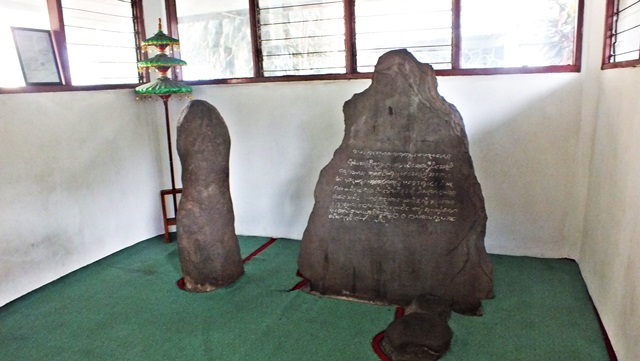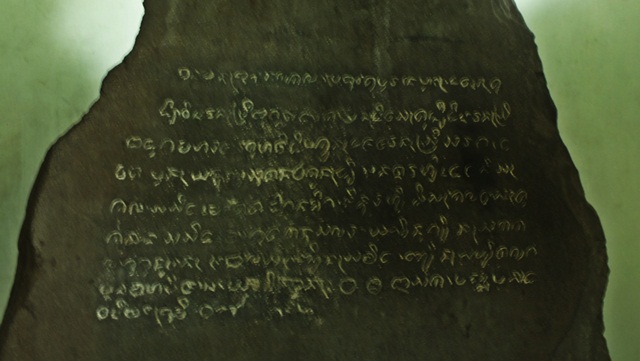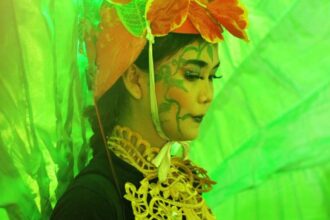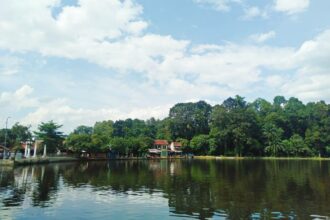Only stones, carved ones. Visitors who don’t like to learn history of a place may not give a glance to this site. However, if you would like to know about why people in Bogor often show their pride to become members of Sundanese, then there is no other place but Batu Tulis Inscription site you should see.
The site is just a small complex located in Southern part of Bogor City. Its right location is right in front of one of Indonesia Presidential Palaces, Batu Tulis Palace. It stands inside a village, now a modern village, named after the inscription.
Batu Tulis Inscription actually refers to several inscribed stones spread inside the complex. There are two or three main stones and with several smaller ones surrounding. In its original state, the site consists of total 15 stones but after a war with Banten Kingdom, there were only few left.

The inscription is very important for Bogor as a city and a society. It represents one phase in the past that can not be separated from the history of the city.
The Batu Tulis Inscription is one of the remains of Sunda Kingdom, or also sometimes mentioned as Galuh Pakuan or Pakuan Pajajaran,
The kingdom, in its glorious time ruled West part of Java before it’s defeted by Islamic Kingdom. At that time, the kingdom placed its capital in the area where Bogor City currently stands.
The site itself represented something important for the Sunda Kingdom itself. The site was built in the year of 1533 to honor the Great King of the Kingdom, Sri Baguda Maharaja Prabu Siliwangi.
Furthermore, the hierarchy of the Kingdom used the site to inaugurate the new kingdom. That’s why when Banten Sultanate defeated Pajajaran Kingdom in a war, their soldiers were instructed to steal one of main stone, Gigilang Stone.
This act was done to prohibit Pajajran Kingdom to have a new king as they could not inaugurate him.

Inside the site, there are two main stones left. One is wide, big and the other is slim and tall. Both represents Lingga and Yoni , the symbols of old culture of Male and female genital.
On the wide stone, there are several sentences carved. All of the sentences show the tribute made by King os Surawisesa, the King of the Kingdom in 1533 to his Great Father, Prabu Siliwangi (the King Siliwangi).
From Wikipedia, the meaning of what were wiritten on the Batu Tulis Inscription means as following
- May (we) be saved (blessed). This is the sign of the late Prabu Ratu, crowned
- with the name Prabu Guru Dewataprana. He was inaugurated (again) with the name Sri
- Baduga Maharaja Ratu Haji in Pakuan Pajajaran Sri Sang Ratu De-
- wata. He is the one that built (defensive) moat of Pakuan. He is the son of Rahyang Nis-
- kala who is buried at Gunatiga, the grandson of Rahyang Niskala Wastu
- Kancana who is buried at Nusa Larang. He is the one who built
- “Gugunungan” (sacred mounds), built “Balay” (pavilion) built Samida forest,[3] built (the lake) Sanghyang Talaga
- Rena Mahawijaya (made) in Saka year “Panca Panda-
- wa mban Bumi”[4] (1455 Saka or 1533 CE).
The Batu Tulis Inscription site is one place that you should visit when you come to this city. Of course, if you are one of the history maniac, like me.


![[PHOTO] A Street Portraitist on Juanda Street Still Exist](https://lovelybogor.com/wp-content/uploads/2023/09/PHOTO-Street-Portraitist-on-Juanda-Street-Still-Survives-330x220.jpg)

![[PHOTO] How Subsidized LPG (Liquid Petroleum Gas) Distributed in Bogor?](https://lovelybogor.com/wp-content/uploads/2023/09/How-Subsidized-LPG-Distributed-in-Bogor-330x220.jpg)

![[PHOTO] No Longer Just A Town, Bogor is a Metropolis](https://lovelybogor.com/wp-content/uploads/2023/09/No-Longer-Just-Town-Bogor-is-a-Metropolis-330x220.jpg)

![[Photo] The East Side, The Old Parts of Bogor Commuter Train Station](https://lovelybogor.com/wp-content/uploads/2022/09/The-old-part-of-Bogor-Commuter-Train-StationIMG_4233-330x220.jpg)
![[Photos] Old Machine Guns From Indonesian Independence Era – Bogor Perjuangan Museum](https://lovelybogor.com/wp-content/uploads/2022/09/Old-Machine-Guns-From-Indonesian-Independence-Era-Bogor-Perjuangan-Museum-3-330x220.jpg)
![[Photos] Two Landmarks of Bogor City – Kujang Monument and The Nine Gates](https://lovelybogor.com/wp-content/uploads/2022/09/Photo-Two-Landmarks-of-Bogor-City-Kujang-Monument-The-Nine-Gates-330x220.jpg)